 W
WEquine anatomy refers to the gross and microscopic anatomy of horses and other equids, including donkeys, and zebras. While all anatomical features of equids are described in the same terms as for other animals by the International Committee on Veterinary Gross Anatomical Nomenclature in the book Nomina Anatomica Veterinaria, there are many horse-specific colloquial terms used by equestrians.
 W
WThe back describes the area of horse anatomy where the saddle goes, and in popular usage extends to include the loin or lumbar region behind the thoracic vertebrae that also is crucial to a horse's weight-carrying ability. These two sections of the vertebral column beginning at the withers, the start of the thoracic vertebrae, and extend to the last lumbar vertebra. Because horses are ridden by humans, the strength and structure of the horse's back is critical to the animal's usefulness.
 W
WBrachygnathism or colloquially parrot mouth, is the uneven alignment of the upper and lower teeth in animals. In serious cases, the upper teeth protrude beyond the lower teeth. Problem with parrot mouth occur if the molars at the back of the mouth are also uneven, resulting in large hooks forming on the upper molars and the rear of the lower back molars. Horses with parrot mouth often require dental treatment at least every six months to remove the hooks and maintain alignment.
 W
WThe chestnut, also known as a night eye, is a callosity on the body of a horse or other equine, found on the inner side of the leg above the knee on the foreleg and, if present, below the hock on the hind leg. It is believed to be a vestigial toe, and along with the ergot form the three toes of some other extinct Equidae. Darren Naish dissents from this belief, noting that the chestnut is "not associated with the metacarpus or metatarsus, the only places where digits occur."
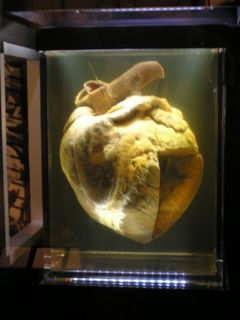 W
WThe circulatory system of the horse consists of the heart, the blood vessels, and the blood.
 W
WThe coffin bone, also known as the pedal bone (U.S.), is the bottommost bone in the front and rear legs of horses, cattle, pigs and other ruminants. In horses it is encased by the hoof capsule. Also known as the distal phalanx, third phalanx, or "P3". The coffin bone meets the short pastern bone or second phalanx at the coffin joint. The coffin bone is connected to the inner wall of the horse hoof by a structure called the laminar layer. The insensitive laminae coming in from the hoof wall connects to the sensitive laminae layer, containing the blood supply and nerves, which is attached to the coffin bone. The lamina is a critical structure for hoof health, therefore any injury to the hoof or its support system can in turn affect the coffin bone.
 W
WCow-hocked (adj.) or cow hocks (n.) describes a defect in the conformation of four-legged animals, primarily of livestock and horses, but also of dogs and cats.
 W
WEquine conformation evaluates the degree of correctness of a horse's bone structure, musculature, and its body proportions in relation to each other. Undesirable conformation can limit the ability to perform a specific task. Although there are several faults with universal disadvantages, a horse's conformation is usually judged by what its intended use may be. Thus "form to function" is one of the first set of traits considered in judging conformation. A horse with poor form for a Grand Prix show jumper could have excellent conformation for a World Champion cutting horse, or to be a champion draft horse. Every horse has good and bad points of its conformation and many horses excel even with conformation faults.
 W
WThe ergot is a small callosity on the underside of the fetlock of a horse or other equine. Some equines have them on all four fetlocks; others have few or no detectable ergots. In horses, the ergot varies from very small to the size of a pea or bean, larger ergots occurring in horses with "feather" – long hairs on the lower legs. In some other equines, the ergot can be as much as 3.8 cm (1.5 in) in diameter.
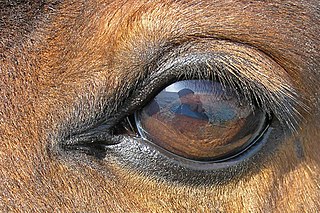 W
WThe equine eye is one of the largest of any land mammal. Its visual abilities are directly related to the animal's behavior; for example, it is active during both day and night, and it is a prey animal. Both the strengths and weaknesses of the horse's visual abilities should be taken into consideration when training the animal, as an understanding of the horse's eye can help to discover why the animal behaves the way it does in various situations.
 W
WFeathering also known as feathers is the long hair on the lower legs of some breeds of horses and ponies. On some horses, especially draft breeds, the hair can almost cover the hooves. While nearly all horses will grow longer hair on the lower legs and back of the fetlocks at times, particularly in the winter, "feather" refers to the particularly long growth that is characteristic of certain breeds.
 W
WFetlock is the common name in horses, large animals, and sometimes dogs for the metacarpophalangeal and metatarsophalangeal joints.
 W
WThe forelock or foretop is a part of a horse's mane, that grows from the animal's poll and falls forward between the ears and onto the forehead. Some breeds, particularly pony breeds, have a naturally thick forelock, while other breeds, such as many Thoroughbreds, have a thinner forelock. Primitive wild equines such as the Przewalski's horse with a naturally short, upright mane generally have no hair falling forward onto the forehead. Other equidae such as donkeys and zebras, have no discernible forelock at all.
 W
WThe frog is a part of a horse's hoof, located on the underside, which should touch the ground if the horse is standing on soft footing. The frog is triangular in shape, and extends mid way from the heels toward the toe, covering around 25% of the bottom of the hoof. It acts as a shock absorber for the foot when it makes impact with the ground, decreasing the force placed on the bones and joints of the leg.
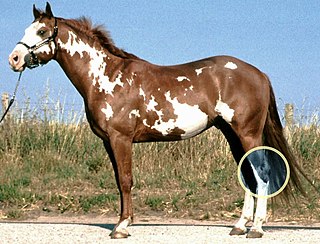 W
WThe hock, or gambrel, is the joint between the tarsal bones and tibia of a digitigrade or unguligrade quadrupedal mammal, such as a horse, cat, or dog. This joint may include articulations between tarsal bones and the fibula in some species, while in others the fibula has been greatly reduced and is only found as a vestigial remnant fused to the distal portion of the tibia. It is the anatomical homologue of the ankle of the human foot. While homologous joints occur in other tetrapods, the term is generally restricted to mammals, particularly long-legged domesticated species.
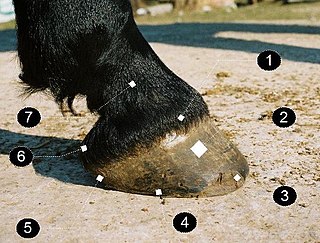 W
WA horse hoof is a structure surrounding the distal phalanx of the 3rd digit of each of the four limbs of Equus species, which is covered by complex soft tissue and keratinised (cornified) structures. Since a single digit must bear the full proportion of the animal's weight that is borne by that limb, the hoof is of vital importance to the horse. The phrase "no hoof, no horse" underlines how much the health and the strength of the hoof is crucial for horse soundness.
 W
WA stallion is a male horse that has not been gelded (castrated). Stallions follow the conformation and phenotype of their breed, but within that standard, the presence of hormones such as testosterone may give stallions a thicker, "cresty" neck, as well as a somewhat more muscular physique as compared to female horses, known as mares, and castrated males, called geldings.
 W
WHorse teeth refers to the dentition of equine species, including horses and donkeys. Equines are both heterodontous and diphyodontous, which means that they have teeth in more than one shape, and have two successive sets of teeth, the deciduous and permanent sets.
 W
WThe limbs of the horse are structures made of dozens of bones, joints, muscles, tendons, and ligaments that support the weight of the equine body. They include two apparatuses: the suspensory apparatus, which carries much of the weight, prevents overextension of the joint and absorbs shock, and the stay apparatus, which locks major joints in the limbs, allowing horses to remain standing while relaxed or asleep. The limbs play a major part in the movement of the horse, with the legs performing the functions of absorbing impact, bearing weight, and providing thrust. In general, the majority of the weight is borne by the front legs, while the rear legs provide propulsion. The hooves are also important structures, providing support, traction and shock absorption, and containing structures that provide blood flow through the lower leg. As the horse developed as a cursorial animal, with a primary defense mechanism of running over hard ground, its legs evolved to the long, sturdy, light-weight, one-toed form seen today.
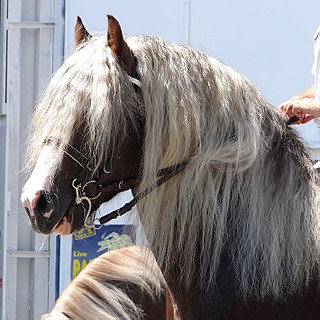 W
WOn horses, the mane is the hair that grows from the top of the neck of a horse or other equine, reaching from the poll to the withers, and includes the forelock or foretop. It is thicker and coarser than the rest of the horse's coat, and naturally grows to roughly cover the neck. Heredity plays a role, giving some horses a longer, thicker mane, and others a shorter, thinner one.
 W
WThe modified triadan system is a scheme of dental nomenclature that can be used widely across different animal species. It is used worldwide among veterinary surgeons.
 W
WThe navicular bone is a small bone found in the feet of most mammals.
 W
WThe chestnut, also known as a night eye, is a callosity on the body of a horse or other equine, found on the inner side of the leg above the knee on the foreleg and, if present, below the hock on the hind leg. It is believed to be a vestigial toe, and along with the ergot form the three toes of some other extinct Equidae. Darren Naish dissents from this belief, noting that the chestnut is "not associated with the metacarpus or metatarsus, the only places where digits occur."
 W
WThe pastern is a part of the leg of a horse between the fetlock and the top of the hoof. It incorporates the long pastern bone and the short pastern bone, which are held together by two sets of paired ligaments to form the pastern joint. Anatomically homologous to the two largest bones found in the human finger, the pastern was famously mis-defined by Samuel Johnson in his dictionary as "the knee of a horse". When a lady asked Johnson how this had happened, he gave the much-quoted reply: "Ignorance, madam, pure ignorance."
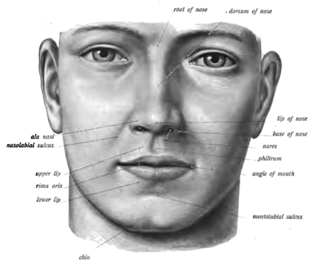 W
WThe philtrum, or medial cleft, is a vertical indentation in the middle area of the upper lip, common to many mammals, extending in humans from the nasal septum to the tubercle of the upper lip. Together with a glandular rhinarium and slit-like nostrils, it is believed to constitute the primitive condition for at least therian mammals. Monotremes lack a philtrum, though this could be due to the specialised, beak-like jaws in living species.
 W
WThe poll is a name of the part of an animal's head, alternatively referencing a point immediately behind or right between the ears. This area of the anatomy is of particular significance for the horse.
 W
WThe respiratory system of the horse is the biological system by which a horse circulates air for the purpose of gaseous exchange.
 W
WThe rump or croup, in the external morphology of an animal, is the portion of the posterior dorsum – that is, posterior to the loins and anterior to the tail. Anatomically, the rump corresponds to the sacrum.
 W
WIn anatomy, a sesamoid bone is a bone embedded within a tendon or a muscle. It is derived from the Latin word sesamum, indicating the small size of most sesamoids. Often, these bones form in response to strain, or can be present as a normal variant. The kneecap is the largest sesamoid bone in the body. Sesamoids act like pulleys, providing a smooth surface for tendons to slide over, increasing the tendon's ability to transmit muscular forces.
 W
WThe skeletal system of the horse has three major functions in the body. It protects vital organs, provides framework, and supports soft parts of the body. Horses typically have 205 bones. The pelvic limb typically contains 19 bones, while the thoracic limb contains 20 bones.
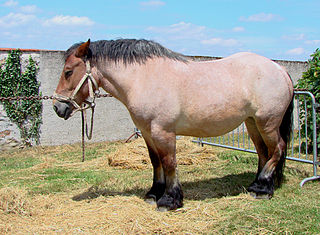 W
WThe stay apparatus is a group of ligaments, tendons and muscles which "lock" major joints in the limbs of the horse. It is best known as the mechanism by which horses can enter a light sleep while still standing up. It does, however, exist in other large land mammals, where it plays a role in reducing fatigue while standing. The stay apparatus allows animals to relax their muscles and doze without collapsing.
 W
WThe stifle joint is a complex joint in the hind limbs of quadruped mammals such as the sheep, horse or dog. It is the equivalent of the human knee and is often the largest synovial joint in the animal's body. The stifle joint joins three bones: the femur, patella, and tibia. The joint consists of three smaller ones: the femoropatellar joint, medial femorotibial joint, and lateral femorotibial joint.
 W
WThe tail of the horse and other equines consists of two parts, the dock and the skirt. The dock consists of the muscles and skin covering the coccygeal vertebrae. The term "skirt" refers to the long hairs that fall below the dock. On a horse, long, thick tail hairs begin to grow at the base of the tail, and grow along the top and sides of the dock. In donkeys and other members of Equus asinus, as well as some mules, the zebra and the wild Przewalski's horse, the dock has short hair at the top of the dock, with longer, coarser skirt hairs beginning to grow only toward the bottom of the dock. Hair does not grow at all on the underside of the dock.
 W
WThe withers is the ridge between the shoulder blades of an animal, typically a quadruped. In many species, it is the tallest point of the body. In horses and dogs, it is the standard place to measure the animal's height. In contrast, cattle are often measured to the top of the hips.
 W
WWolf teeth are small, peg-like horse teeth, which sit just in front of the first cheek teeth of horses and other equids. They are vestigial first premolars and the first cheek tooth is referred to as the second premolar even when wolf teeth are not present. Torbjörn Lundström in Sweden reported that about 45-50% of 25000 horses had wolf teeth. They are much less common in the mandible than the maxilla although mandibular wolf teeth are found very occasionally.